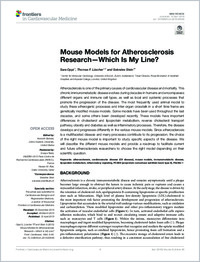Mouse Models for Atherosclerosis Research-Which Is My Line?
- Oppi S Center for Molecular Cardiology, University of Zurich, Zurich, Switzerland.
- Lüscher TF Center for Molecular Cardiology, University of Zurich, Zurich, Switzerland.
- Stein S Center for Molecular Cardiology, University of Zurich, Zurich, Switzerland.
- 2019-04-30
Published in:
- Frontiers in cardiovascular medicine. - 2019
Fibrillin 1
PCSK9 (proprotein convertase subtilisin kexin type 9)
atherosclerosis
cardiovascular disease (CV disease)
immunometabolic disease
inflammatory signaling
lipoprotein metabolism
mouse models
English
Atherosclerosis is one of the primary causes of cardiovascular disease and mortality. This chronic immunometabolic disease evolves during decades in humans and encompasses different organs and immune cell types, as well as local and systemic processes that promote the progression of the disease. The most frequently used animal model to study these atherogenic processes and inter-organ crosstalk in a short time frame are genetically modified mouse models. Some models have been used throughout the last decades, and some others been developed recently. These models have important differences in cholesterol and lipoprotein metabolism, reverse cholesterol transport pathway, obesity and diabetes as well as inflammatory processes. Therefore, the disease develops and progresses differently in the various mouse models. Since atherosclerosis is a multifaceted disease and many processes contribute to its progression, the choice of the right mouse model is important to study specific aspects of the disease. We will describe the different mouse models and provide a roadmap to facilitate current and future atherosclerosis researchers to choose the right model depending on their scientific question.
- Language
-
- English
- Open access status
- gold
- Identifiers
-
- DOI 10.3389/fcvm.2019.00046
- PMID 31032262
- Persistent URL
- https://sonar.ch/global/documents/127279
Statistics
Document views: 10
File downloads:
- fulltext.pdf: 0
